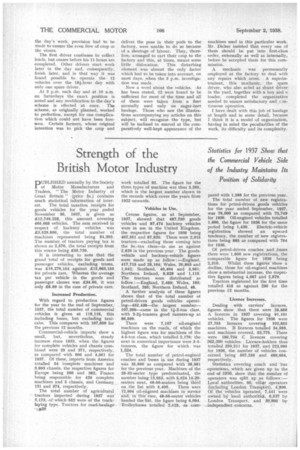Strength of the British Motor Industry
Page 48

If you've noticed an error in this article please click here to report it so we can fix it.
Statistics for 1937 Show that the Commercial Vehicle Side of the Industry Maintains Its Position of Solidarity PUBLISIIED annually by the Society of Motor Manufacturers and Traders, " The Motor Industry of Great Britain " (price 5s.) contains much statistical information of inter
est. The total taxation receipts for goods vehicles for the year ended November 30, 1937, is given as R12,746,258, this amount covering 465,668 vehicleS. The sum received in respect of hackney vehicles was £3,529,896, the total number of machines represented being 84,393. The number of tractors paying tax is shown as 2,570, the total receipts from this source being £95,739.
It is interesting to note that the grand total of receipts for goods and passenger vehicles, excluding trams, was e16,276,154 against £15,663,155 for private cars. Whereas the average tax per vehicle in the goods and passenger classes was E.34.60, it was only £8.89 in the case of private cars.
Increased Production.
With regard to production figures for the year to the end of September, 1937, the total number of commercial vehicles is given at 118,116, this including buses, but excluding taxicabs. This compares with 107,609 for the previous 12 months.
Commercial-vehicle imports show a small, but, nevertheless, steady increase since 1933, when the figures for complete vehicles and chassis combined were 29 and 371, respectively, as compared with 606 and 4,061 for " 1937. Of these, imports from America totalled 54 Complete machines and 3,693 chassis, the respective figures for Europe being 560 and 382. France being responsible for 426 complete machines and 5 chassis, and Germany 131 and 374, respectively.
The total number of agricultural tractors imported during 1937 was 3,173, .of-which552 were of the tracklaying type. Tractors for road-haulage
work totalled 92. The figure for the three types of machine was thus 3,265, which is the largest number shown in the records which cover the years feani 1922 onwards.
Vehicles in Use.
Census figures, as at September, 1937, showed that 487,750 goods vehicles and 87,474 hackney vehicles were in use in the United Kingdom, the respective figures for 1936 being 467,561 and 87.820. There were 2,915 tractors-excluding those coming into the Ss.-tax class-in use as against 2,820 in the previous year. The goodsvehicle and hackney-vehicle figures were made up as follow :-England. 417,715 and 29,164; Wales, 20,803 and 1,642; Scotland, 40,404 and 3,981; Northern Ireland, 8,828 and 1,119. The tractors were distributed as follow :-England, 2,469; Wales, 103; Scotland, 295; Northern Ireland, 48.
A further analysis of these figures shows that of the total number of petrol-driven goods vehicles operating-452.438-the largest number107,266-came in the 1e-2-ton class, with 2-21-ton_ners good runners-up at 96,560.
There were 7,107 oil-engined machines on the roads, of which the highest figure was for machines of the 4-5-ton class, which totalled 2,176; the next in numerical importance were 3-4tonners, the figure for which was 1,524.
The total number of petrol-engined coaches and buses in use during 1937 was 35,860 as compared •Cvith 38,981 for the previous year. Machines of the 26-32-seater type predominated, the number being 13,653, with 5,521420seaters next, 48-56-seaters being third on the list with 5,400. There were 12,994 oil-engined machines inservice and in this case, 48-56-seater vehicles headed the list, the figure being 6,094. Trolleybuses totalled 2,425, as coin pared with 1,588 for the previous year.
The total number of new registrations for petrol-driven goods vehicles for the year ended September, 1937, was 76,000 as compared with 73,749 for 1936. Oil-engined vehicles totalled 1,660, the figure for 1936 for the same period being 1,430. Electric-vehicle registration showed an upward tendency, the number of new registrations being 885 as compared with 784 for 1936.
Of petrol-driven coaches and buses there were 1,800 new registrations, the comparable figure for 1936 being 2,310. Whilst these figures show a decline, those for oil-engined machines show a substantial increase, the respective figures being 4,007 and 2,879.
Tractors registered for the first time totalled 415 as against 290 for the previous 12 months.
Licence Increases.
Dealing with carriers' licences, .figures, show that there were 2e,888 A licences in 1937 covering 91,101 vehicles. The figures for 1936 were 27,755 licences covering 102,855 machines. B licences totalled 34,589, and machine..s covered, 53,775. There were 186,734 C licences covering 362,380 vehicles. Licence-holders thus totalled 250,211 for 1937, and 223,095 for 1936, the number of vehicles concerned being 507,256 and 489,664, respectively.
Statistics covering coach and 'bus operations, which are given up to the end of 1936, show that the number of operators was split up as follows:Local" authorities, 95; other operators (including London Transeiare), 4896. Of the vehicles operated, 7,441 were owned by local authoritice, 6,537 by London Transport, and 33,995 by Anclependent.concerns.




















































































